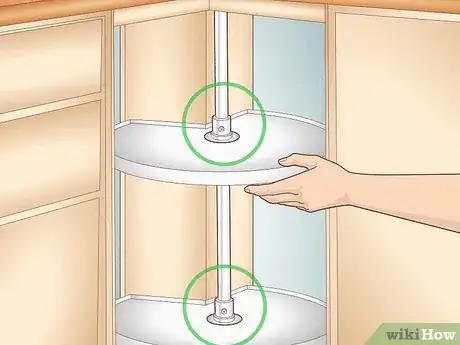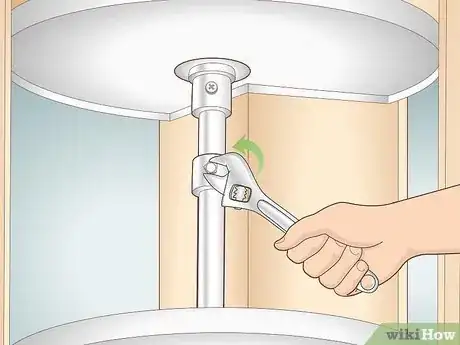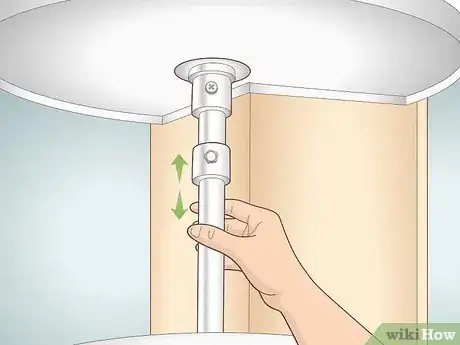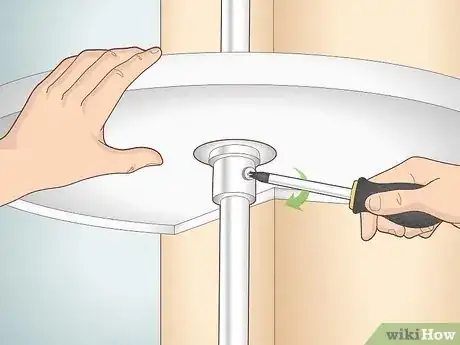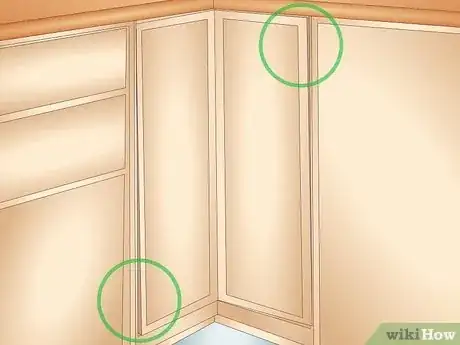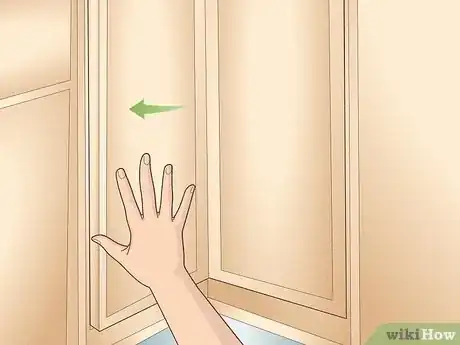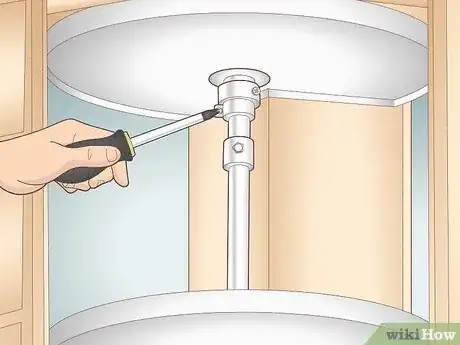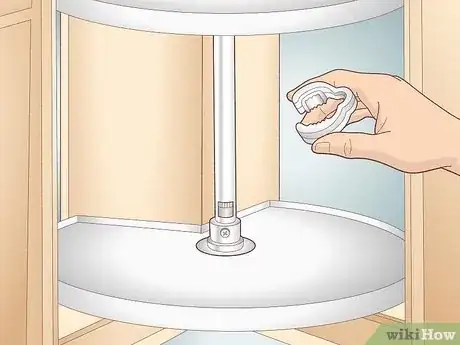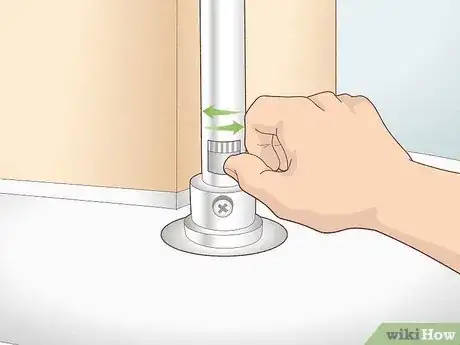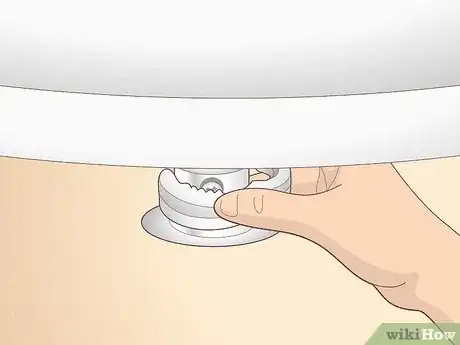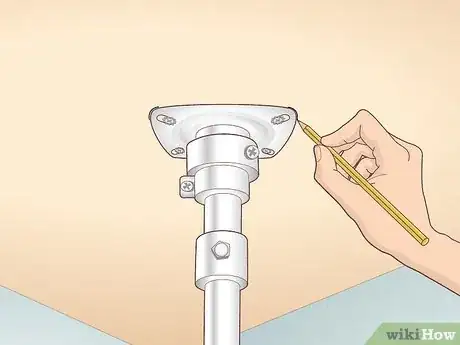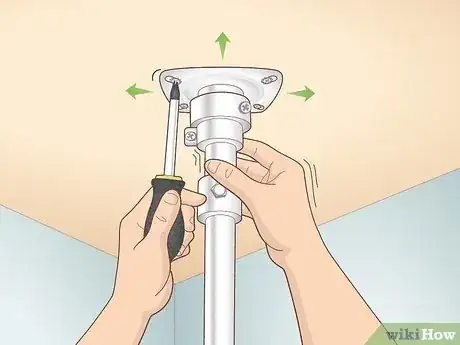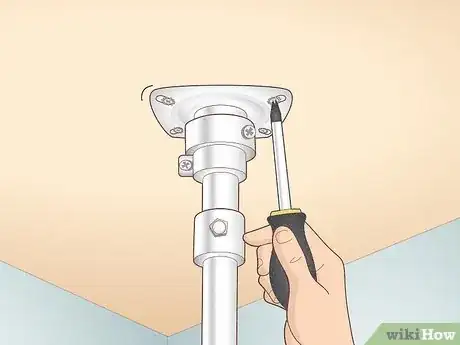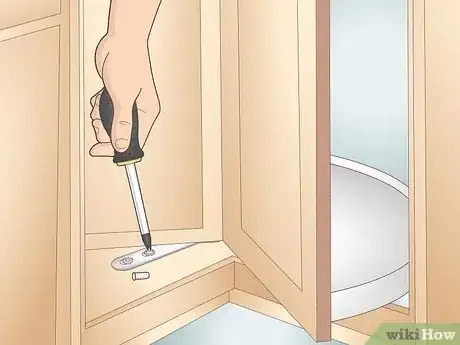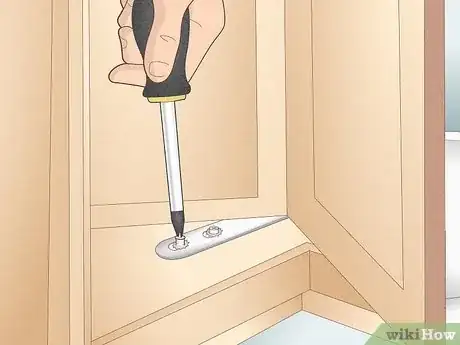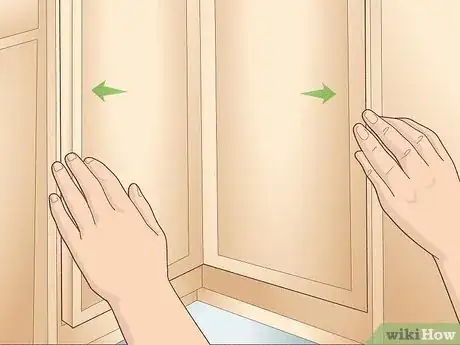This article was co-authored by Josh Goldenberg. Josh Goldenberg is a Residential Remodeling Expert and the Co-Founder of 5blox, based in the Greater Los Angeles area. With more than seven years of experience, Josh and his team specialize in luxurious and sustainable home renovations. 5blox is fully licensed and bonded.
This article has been viewed 214,670 times.
Adjusting misaligned Lazy Susan units might seem intimidating, but the most common corrections you'll need to make can be done at home using standard tools. Fix rotation problems by adjusting the center shaft or bottom shelf position. Remedy misaligned doors by correcting the door position from inside the overall unit.
Steps
Correcting Poor Rotation
-
1Pinpoint where rotation problems are occurring. When a Lazy Susan becomes stiff and difficult to rotate, the problem is usually caused by either the center shaft or the position of its bottom shelf. Lightly spin the Susan and note where it locks up, has difficulty turning, or has poor clearance.
- If the center movable shelf begins to bind, it will prevent free rotation. In this situation, you’ll need to loosen this shelf.
- If the circular shelves slip down the center shaft, the bottom shelf can begin to drag, making it difficult to turn. You will need to adjust the height of this shelf to fix the problem.
-
2Locate the locking bolt to adjust the center shaft. Look at the top of the center shaft. There should be one large bolt locking the exterior shaft to a metal sleeve positioned inside the shaft. This is the locking bolt for the shaft.[1]
- This bolt holds the center shaft in place and maintains the length of the shaft. Sometimes excess pressure from this bolt can cause the shaft to bind.
- On some models, the locking bolt might be located at the bottom of the Susan, however, in most cases, it will found near the top.
Advertisement -
3Loosen the bolt. If anything is inside your Lazy Susan, empty it so you have more space to work. Using a wrench or ratchet, loosen the bolt by turning it one-quarter of a full rotation counterclockwise. At first, the bolt may require some elbow grease to break loose.
- Only loosen the bolt enough to manipulate the hardware inside the center shaft. On some models, this might require more or less than one-quarter rotation.
- Generally, it’s better to loosen the bolt in small increments. This will prevent you from loosening it too much, which could result in the alignment of the Susan being thrown off.
-
4Move the adjusting rod. Now that the bolt is loose, you’ll be able to adjust the center shaft. Slide the metal adjusting sleeve the bolt was holding in place no more than 1 inch (2.5 cm) to provide better clearance between the center shaft and top of the cabinet.[2]
- Work in small increments when adjusting the center shaft. Large adjustments could cause the Lazy Susan to topple over.
-
5Tighten the bolt to finish adjusting the center shaft. Use your wrench or ratchet to carefully refasten the locking bolt in place. Do not over-tighten the bolt. It should be looser than it was initially, but still tight enough to hold the adjusting rod in place.[3]
-
6Locate the locking screws to adjust the shelf position. Most Lazy Susans should have two or more locking screws located at the center of each shelf. These screws hold the shelves to the center shaft.
- When all of the shelves are held together by the front decorative panel, you will need to adjust the entire shelf system. In this case, there may not be screws located at the height of each shelf.
- If the shelves must be adjusted separately, you'll only need to work with the bottom shelf. Locate the locking screws in the bottom shelf only.
-
7Loosen the screws. Loosen the locking screws using a Phillips-head screwdriver or similar tool. Hold the screwdriver so its head meets the fastener straight on. Apply firm pressure down on the screw while turning counterclockwise to prevent stripping fastener hardware.[4]
- Screws can be left in their holes once they have been unattached from the center shaft. However, you may want to set loosened screws off to the side to prevent any from getting lost.
-
8Raise the shelves to finish adjusting shelf position. Carefully lift the bottom shelf or entire shelf system until there is roughly half an inch (1.25 cm) of space between the bottom shelf and the bottom of the cabinet.
- The shelves may resist this adjustment and begin binding on the center shaft. Maneuver shelves until they are level and at a suitable height.
- Under no circumstances should you lubricate the center shaft. Doing so could prevent the screws from holding their position.
-
9Tighten the screws. Hold the shelf in place with one hand and use your free hand to tighten the locking screws back in place with a screwdriver. Take care not to let the shelf slip as you reattach fasteners, as this could cause it to become uneven or binding.[5]
- Make the screws as tight as possible without stripping any of the hardware. The shelves must be stationary and secure to prevent this kind of misalignment.
Fixing an Uneven Door
-
1Locate where there are door problems. Door problems are usually easier to identify than rotation problems. The door of the unit may close unevenly or it may not have sufficient clearance at the top, bottom, or sides of the cabinet.
- If the door does not close completely, or if it closes unevenly, you'll need to adjust the doors until they are centered correctly within the frame.
- When the top or bottom clearance is insufficient, you'll notice the gaps at both sides of the door will be unequal.
- When the side clearance is insufficient, the door will appear crooked. Additionally, the gaps around it will but unequal.
-
2Loosen the collar screw when doors close unevenly. Open the door and locate the collar at the top of the unit. For many models, this part will be made of white plastic. Use a Phillips-head screwdriver to loosen the screw on this collar.
- Loosen the screw by one full counterclockwise rotation. Even loosened, the screw should remain in its position in the collar.
-
3Rotate the shelf unit and door counterclockwise. Using both hands, carefully rotate the entire shelf unit and door in a counterclockwise direction. Continue until the collar hits the catch latch located at the back of the ceiling bracket.[6]
- Turn the Lazy Susan slowly. Listen for a slight click. This is a signal that you've reached the catch latch.
- Once you hit the catch latch, the collar should be properly aligned with the spring. You should feel a slight resistance to additional counterclockwise turning.
-
4Rotate the door. Gradually rotate the door in a clockwise direction until it reaches the exact center-front. If possible, take a step back and check the alignment from a distance. Make sure the door is precisely in place before moving on.
- The plastic collar should remain fixed in place as you rotate the door, so it may be difficult to step away. Have a friend or family member help you evaluate the door position, in these cases.
- If you accidentally rotate past the center-front position, continue rotating the door in a clockwise direction. Do not rotate it counterclockwise until after you finish setting it.
-
5Turn the entire assembly. Carefully and slowly rotate the entire assembly in a counterclockwise direction. Continue turning the assembly until the collar screw faces you. The door and collar should maintain their alignment as you turn the assembly.[7]
- It may help you to maintain the position of the collar and door by marking their correct positions with a piece of painter’s tape, masking tape, or something similar.
-
6Tighten the screw to finish adjusting uneven doors. Tighten the collar screw back into its original position. The door should now be properly aligned and fixed into place. Give the Lazy Susan a few spins to check that everything works correctly, and your door adjustment is finished.[8]
- To prevent the collar from twisting out of place while it’s fastened, you may need to hold it in place as the screw is tightened.
Correcting Insufficient Top, Bottom, and Side Clearance
-
1Remove the retainer clip to improve top and bottom clearance. Locate the plastic retainer clip at the bottom of the center shaft. Firmly grasp the clip between your fingers, open it, and pull it out. Under the clip should be a cut-out portion of the shaft with a thumbscrew adjustment wheel.
- The cabinet will need to be completely empty when you make this adjustment. Do not attempt to complete the process when the shelves are loaded, especially if they are heavily loaded.
-
2Turn the adjustment wheel. Use your fingers to turn the thumbscrew adjustment wheel in the cut-out portion of the center shaft. Rotate the wheel clockwise to raise the door and counterclockwise to lower the door.
- Generally you can expect that for each full rotation of the screw the height will be adjusted by about 1/32 in (0.8 mm).
- You may need to apply gentle pressure to the underside of the bottom shelf to aid the adjustment if you are attempting to raise the door.[9]
-
3Replace the retainer clip to complete the top and bottom adjustment. After adjusting the door to the proper height, return the retainer clip to its original position at the bottom of the pole. The clip should fasten back into place firmly.[10]
- It's a good idea to tighten all of the adjustment screws attached to the center shaft, shelves, and door after setting the height. Doing this could prevent the door from falling out of alignment again.
-
4Outline the top and bottom brackets when side clearance is insufficient. Using an erasable pencil, lightly outline the current position of the top and bottom brackets. If lighting is too poor inside the cabinet to make these marks easily, use a flashlight or electric lantern.
- Doing this will give you a reference point to work from as you make the adjustment. Pencil marks can be erased once you complete the process.
-
5Realign the pivot pole from the top. Use a screwdriver to remove the setscrews and loosen the star washers holding the pivot housing in place on both sides of the pivot pole. Adjust the pivot housing and pivot pole until both are centered and aligned.[11]
- When the star washers are in place but before fastening the setscrews, take a step back and look over your Lazy Susan. If the side clearance is still uneven, remove the washers and readjust the pivot.
- Use your outline to guide your adjustments. For example, if the left side is low, you’ll likely need to move the pivot pole and housing to the right.
-
6Refasten the pivot housing. Once you tighten the star washers, you’ll be ready to return the setscrews to their original position. When the screws are in place, check the side clearance of the Lazy Susan again to make sure that it wasn't altered as you refastened its hardware.[12]
- This adjustment may take care of your side clearance problem. If the lower half of your Susan appears to be misaligned, you’ll have to adjust the pivot base in addition to its top.
-
7Realign the pivot base when necessary. Open the door wide enough to expose the bottom bracket on either side of the Susan. Loosen this bracket by removing the fastening setscrew and star washer with a screwdriver. Now you can realign the pivot cam (metal arm) base so that it’s centered.[13]
- You’ll have to repeat this process on the opposite side of the Lazy Susan where you’ll find an identical bracket/pivot cam base.
- Work on brackets one at a time. After you’ve taken apart, realigned, and refastened the first bracket, move on to the next one.
- When properly centered, the pivot cam bases of both sides should be aligned with regard to the center pole.
-
8Refasten the bracket. Be careful when refastening; if you jostle the pivot cam, it could be knocked out of alignment. Replace the star washers and reattach the setscrews for the bracket. When fastened, similarly adjust the opposite side bottom bracket/pivot cam base.
- Verify that the position did not become altered while you were returning these pieces to their original positions by stepping back and evaluating the evenness of the side clearance.
-
9Check the door to complete your side clearance adjustment. Sometimes these alignments (especially those made to pivots) can require several attempts before they are resolved. Double check door alignment after completing the top and bottom adjustments, especially.[14]
- If the side clearance is still unequal, you will need to readjust the top pivot pole and/or bottom pivot cams.
Community Q&A
-
QuestionHow do I tighten a Lazy Susan that keeps turning around and around? It won't lock in place.
 Community AnswerThere is a plastic clasp at the top of the Lazy Susan. You will see a notch in it that should catch so that it holds the unit in place. Commonly, the older units will show the plastic to be worn. Simply replace the plastic piece, and it should realign and close properly.
Community AnswerThere is a plastic clasp at the top of the Lazy Susan. You will see a notch in it that should catch so that it holds the unit in place. Commonly, the older units will show the plastic to be worn. Simply replace the plastic piece, and it should realign and close properly. -
QuestionWhat shelf do I put the heavy items on, top or bottom?
 Community AnswerPutting the heavy items like canned goods on top will increase the chances of the shelf breaking, so put heavy stuff not the bottom instead. The top shelf is better for boxes of pasta and bags of rice.
Community AnswerPutting the heavy items like canned goods on top will increase the chances of the shelf breaking, so put heavy stuff not the bottom instead. The top shelf is better for boxes of pasta and bags of rice. -
QuestionHow do I fix set screws that won't tighten?
 Community AnswerIf the screws for your Lazy Susan don't tighten, the fasteners or the attaching hardware may be stripped. This means that damage has been done to the part of the hardware intended to grip the fastener (like the grooves of a screw). Replace stripped hardware and try again.
Community AnswerIf the screws for your Lazy Susan don't tighten, the fasteners or the attaching hardware may be stripped. This means that damage has been done to the part of the hardware intended to grip the fastener (like the grooves of a screw). Replace stripped hardware and try again.
Things You'll Need
- Eraser
- Flashlight (or electric lantern for light; optional)
- Pencil
- Phillips-head screwdriver
- Standard screwdriver
- Wrench (or ratchet set)
References
- ↑ https://www.canyoncreek.com/wp-content/uploads/2022/02/LazySusan-FBCC36REVS-Door-Adjust.pdf
- ↑ https://kraftmaid.s3.amazonaws.com/content/pdf/care-cleaning-guide-march-2014.pdf
- ↑ https://www.canyoncreek.com/wp-content/uploads/2022/02/LazySusan-FBCC36REVS-Door-Adjust.pdf
- ↑ https://kraftmaid.s3.amazonaws.com/content/pdf/care-cleaning-guide-march-2014.pdf
- ↑ https://www.canyoncreek.com/wp-content/uploads/2022/02/LazySusan-FBCC36REVS-Door-Adjust.pdf
- ↑ https://kraftmaid.s3.amazonaws.com/content/pdf/care-cleaning-guide-march-2014.pdf
- ↑ https://kraftmaid.s3.amazonaws.com/content/pdf/care-cleaning-guide-march-2014.pdf
- ↑ https://www.canyoncreek.com/wp-content/uploads/2022/02/LazySusan-FBCC36REVS-Door-Adjust.pdf
- ↑ https://www.canyoncreek.com/wp-content/uploads/2022/02/LazySusan-FBCC36REVS-Door-Adjust.pdf
- ↑ https://kraftmaid.s3.amazonaws.com/content/pdf/care-cleaning-guide-march-2014.pdf
- ↑ https://www.canyoncreek.com/wp-content/uploads/2022/02/LazySusan-FBCC36REVS-Door-Adjust.pdf
- ↑ https://kraftmaid.s3.amazonaws.com/content/pdf/care-cleaning-guide-march-2014.pdf
- ↑ https://www.canyoncreek.com/wp-content/uploads/2022/02/LazySusan-FBCC36REVS-Door-Adjust.pdf
- ↑ https://www.canyoncreek.com/wp-content/uploads/2022/02/LazySusan-FBCC36REVS-Door-Adjust.pdf
About This Article
If you’re having issues with your Lazy Susan, you should be able to adjust it using standard tools. Before you make any adjustments, empty the cupboard so you have space to work. If the shelves are stiff when you turn them, loosen the locking bolt at the top of the center shaft with a wrench or ratchet, then move the adjusting rod an inch, and tighten the bolt. To fix the shelf height, unscrew the locking screws on the central shaft that hold each shelf, adjust the height, then tighten the screws again. If the doors are misaligned, use a Philips-head screwdriver to loosen the screw at the top of the doors, rotate the shelf unit and door counterclockwise until the top hits the latch, then rotate the door clockwise until it reaches the center. For more tips, including how to adjust the clearance inside your Lazy Susan, read on!
